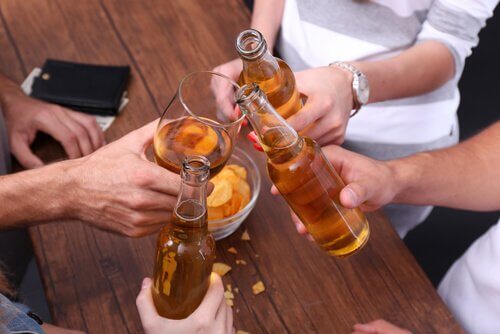You left work and, like every Friday afternoon, you stopped drinking with friends, it’s almost a tradition and it’s your only way to stay in touch with your loved ones, but this afternoon will be different, a friend of yours will give you some news. That will surprise everyone: he has been diagnosed with alcoholism and this habit of quitting drinking every Friday is part of the problem.
This bomb is shocking you and your friends. Everyone thinks it’s a joke, but it’s not, it’s a real problem and, unfortunately, very common, but also very difficult to understand. It’s hard to understand why you drink too, also go to these meetings with friends, participate in this habit, but you’re not an alcoholic, at least that’s what you think.
- So doubts and questions begin.
- What makes you an alcoholic?Why are some people more sensitive to alcoholism than others?Can a habit lead to alcoholism? Read on and you’ll find answers.
Diagnostic classifications, such as DSM-5, leave alcohol use disorder outside the criteria needed for diagnosis as “a group of physical and behavioral symptoms, including withdrawal symptoms, tolerance, and intense desire to consume. “
However, the criteria include frequency and recurrent alcohol consumption as an essential element of its diagnosis, but can this recurrent consumption be considered a habit?
Can this habit become addiction? The answer is a non-categorical, an addiction, in this case alcoholism, is a disease that develops due to various biopsychosocial factors, from a simple habit of abuse, which alters the brain structure and behavior of the person.
That is, it is a combination of biological, social and behavioral factors that make a habit like drinking with friends become something more serious, an addiction, it is complicated because there are some factors that we control and others that we cannot control, besides, it is difficult to predict who will develop or develop the same addiction to a similar situation.
So why in this group of friends that we talked about at the beginning of the article, one will develop alcoholism and the others will not?Factors influencing the development of alcohol dependence can be summarized by:
Biological factors that contribute to the development of alcoholism range from genetic inheritance to alteration of different neurotransmitters and brain structures favored by the habit of consuming alcohol, which in the case of individuals predisposed to addiction is a very rapid change.
Alcohol-related disorder is easier to detect in family members: 40-60% of the risk of alcoholism is due to genetic influences; In addition, the risk is three to four times higher for children of people with alcohol-related disorders.
With regard to brain structures and neurotransmitters, dopamine has been found to be involved in the onset of addictions by being related to pleasure, as well as to the so-called brain reward system, composed mainly of the ventral tegmental zone, among others. Structures.
The person’s perception of alcohol consumption and consumption can be very important, in the group of friends we talked about at the beginning of the article, probably the one who developed alcoholism was the one who drank much more than the others.
In addition, it puts your health at risk by generating a harmful habit, which is no longer manageable to become addiction, so patterns of behavior during adolescence, where this type of habit begins, must be controlled by adults. the need for social acceptance and validation is very important.
Also very important is the perception of alcohol consumption behavior and the availability of alcohol in the environment in which the person lives. Studies show that in more permissive societies with alcohol, alcohol rates are higher.
Therefore, we must point out that there is a thin line between alcohol consumption and alcoholism, in this line there are factors that are under the control of the person himself, such as his behavior, and others that are not, such as biological risk. You have to be very careful and consume alcohol in moderation, or even avoid drinking it.

